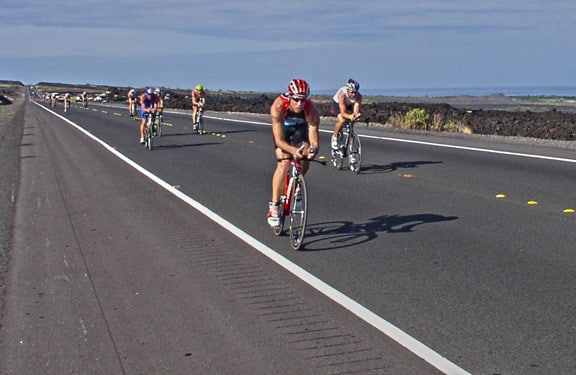
Ironman Training: Don’t let hydration crisis derail your Ironman
By Chris Carmichael
Coming into a major event like an Ironman triathlon, you have likely left very little to chance. Your hydration and nutrition strategy has been tested in training, your equipment has been scrutinized for optimal fit and comfort, and you’ve been focused on your training for many months. That level of preparation maximizes the chances that your race will progress according to your plan, but to be truly prepared for competition you should also know the steps you’re going to take if your plan starts to unravel.
The environment is always one of the biggest challenges facing Ironman competitors, and in order to perform at your best it’s important to keep a close watch on your hydration status and core temperature. In hot environments you lose fluids more quickly, both through respiration and perspiration. Keep in mind that sweat evaporates very quickly; athletes from humid environments – who are accustomed to soaked clothes and sweat that’s clearly visible on their skin – often underestimate how much fluid they’re losing.
If you start experiencing symptoms of a hydration crisis during your race, remember that you can bring yourself back from the brink and still finish strong. Here are some guidelines for getting back on track quickly:
1. Separate your nutrition and hydration sources: Prioritize fluids and electrolytes over calories, especially because many athletes experience greater nausea when consuming calories in a dehydrated, overheated state. Choose an electrolyte drink or a combination of water and electrolyte tablets. You’re still going to need energy, but get the fluids and electrolytes in first, give them 5-10 minutes to get into the system before introducing calories.
2. Slow down and get wet: I know it’s Ironman, but your choices are slow down for 5-10 minutes now or slow down – or stop altogether – later. If you continue at your current intensity level, your core temperature will continue to rise while the fluids you’re consuming are still making their way to the source of the problem. Dump water over your head and body to assist with evaporative cooling, and reduce your pace on the bike or run by 10%.
3. Work the problem: If you retreat into your head and go into survival mode, you’re going to plod along and gradually get slower. You need to stay actively engaged in working through your rough patch. Attitude and action will get to the other side and you can come out of it strong. Don’t get discouraged or feel like you’ve somehow failed because you got into trouble; if you’re pushing yourself for a great result then at some point you’re going to be on that edge of a hydration, nutrition, or physical crisis. Your race is not over and neither are your chances for a PR; the sports’ greatest athletes have to solve the same problems on their way to winning.
► Free Cycling Training Assessment Quiz
Take our free 2-minute quiz to discover how effective your training is and get recommendations for how you can improve.
Chris Carmichael is the CEO and Head Coach of Carmichael Training Systems. He coached Ironman World Champion Peter Reid and CTS coach Nick White worked with Ironman World Champion Craig Alexander.
► FREE Mini-Course: Learn How to Maximize Your Limited Training Time
Learn step-by-step how to overcome limited training time and get faster. Walk away with a personalized plan to increase your performance.
